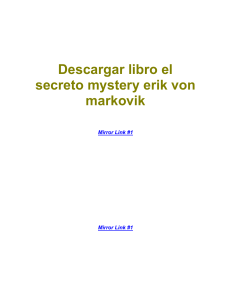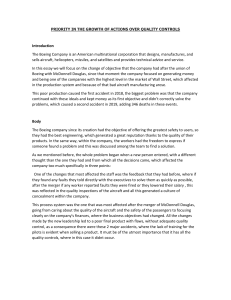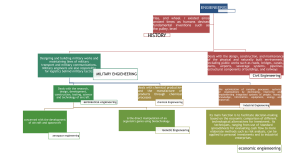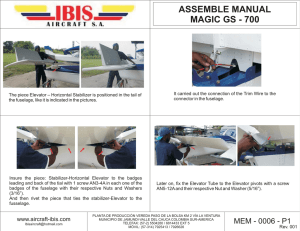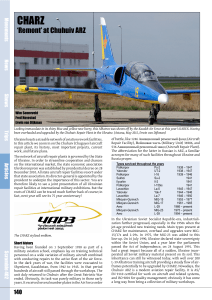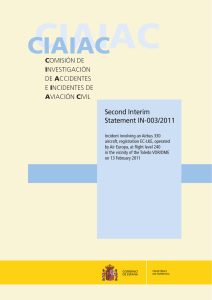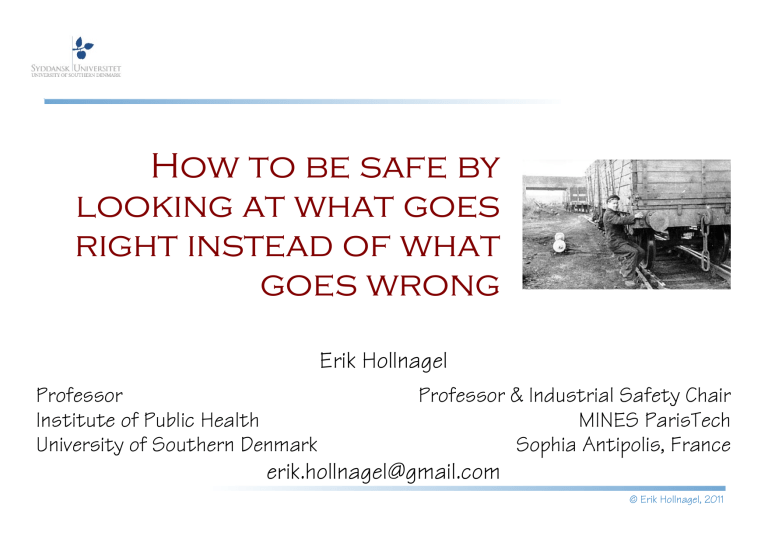
How to be safe by looking at what goes right instead of what goes wrong Erik Hollnagel Professor Institute of Public Health University of Southern Denmark Professor & Industrial Safety Chair MINES ParisTech Sophia Antipolis, France erik.hollnagel@gmail.com © Erik Hollnagel, 2011 The meaning of safety From French Sauf = unharmed / except How can it be done? How much risk is acceptable? How much risk is affordable SAFETY = FREEDOM FROM UNACCEPTABLE RISK What can go wrong? Prevention of Protection against unwanted events unwanted outcomes Unwanted outcome Unexpected event LIFE PROPERTY MONEY Normal performance Accidents, incidents, … © Erik Hollnagel, 2011 Safety measured by what goes wrong Safety is normally measured by the absence of negative outcomes. This can be achieved in three different ways: - eliminating hazards (design), - preventing initiating events (constraints) - protecting against consequences (barriers) What happens when there is no measurable change? Safety, as commonly practised, implies a distinction between: Everyday operations that ensure the system works as it should and produces the intended outcomes. Unusual operations that disrupt or disturb everyday operations or otherwise render them ineffective. The purpose of safety management is to maintain everyday operations by preventing disruptions or disturbances. Safety efforts are usually driven by what has happened in the past, and are therefore mainly reactive. © Erik Hollnagel, 2011 Industrial safety model Events that do not lead to loss of control Events that may, or may not, lead to loss of control Possible outcomes from loss of control Elimination Preventive of initiating conditions Protection against outcomes © Erik Hollnagel, 2011 Safety Performance Assessment Transport Canada A railway company shall maintain records of the following information for the purpose of assessing its safety performance: Accident and incident investigation reports and a description of the corrective actions taken for accidents and incidents that meet the reporting criteria. Accident rates expressed as follows: Employee deaths, disabling injuries and minor injuries, per 200,000 hours worked by the employees of the railway company. Train and grade crossing accidents that meet the reporting criteria, per million train miles. At the request of the Minister, a railway company shall collect, maintain and submit to the Minister specified performance or safety data for the purpose of monitoring the effectiveness of its safety management system and its safety performance. © Erik Hollnagel, 2011 ERA Generic Occurrence Investigation 1: Safety occurrence notification 2: Immediate facts of the occurrence 3: Decision to investigate 6: Reconstruction of the occurrence 5: ‘Complete’ factual information 4: Further factual information gathering 7: Occurrence scenario 8: Analysis 9: Causal factors 10: Recommendations 14: Publication and monitoring 13: Final report 12: Consultation 11: Draft report © Erik Hollnagel, 2011 Looking for causes Single causes Simple causes Belief in causality Technical failure If something has gone wrong (effect), we can find the cause by reasoning backwards Human failure But which assumptions do we make about how things work? Organisational failure And what is our model of how accidents happen? “Act of god” © Erik Hollnagel, 2011 Sequential thinking (cause-effect) Starting from the effect, you can reason backwards to find the cause Starting from the cause, you can reason forwards to find the effect © Erik Hollnagel, 2011 Causality in simple systems If a physician heal the broken bone or diseased soft part of a man, the patient shall pay the physician five shekels in money. If he were a freed man he shall pay three shekels. If he were a slave his owner shall pay the physician two shekels. If a physician make a large incision with an operating knife and cure it, or if he open a tumor (over the eye) with an operating knife, and saves the eye, he shall receive ten shekels in money. If the patient be a freed man, he receives five shekels. If he be the slave of some one, his owner shall give the physician two shekels. If a physician make a large incision with the operating knife, and kill him, or open a tumor with the operating knife, and cut out the eye, his hands shall be cut off. If a physician make a large incision in the slave of a freed man, and kill him, he shall replace the slave with another slave. If he had opened a tumor with the operating knife, and put out his eye, he shall pay half his value. © Erik Hollnagel, 2011 Causality in complex systems Historically, the physician-patient relation was one-to-one. The first modern hospital (The Charité, Berlin) is from 1710. In a one-to-one relation, it makes sense to assign praise – and blame – directly to the physician. Staff: ~ 8.000 (Rigshospitalet, 2008) Number of bed days 322.033 Number of surgical operations 43.344 Number of outpatients 383.609 Average duration of stay 5,2 days Does it still make sense to think of direct responsibility? © Erik Hollnagel, 2011 Three types of accident models Age of safety management Age of human factors Age of technology 1850 1900 1950 2000 Simple linear model Sequential Independent causes, Failures, malfunctions Complex linear model Interdependent causes Epidemiological (active + latent) Non-linear model Tight couplings, coincidences, Systemic resonance, emergence T C T FAA Maintenance oversight I C O I Certification O Aircraft design knowledge P R T Aircraft C P R Interval approvals T Interval approvals C High workload T Aircraft design I Procedures End-play checking I Mechanics P Redundant design O P T Expertise Controlled stabilizer movement C Jackscrew up-down movement I Excessive end -play High workload T C Procedures O P Lubrication P O R T C P O I R Jackscrew replac ement O R Limited stabilizer movement C Horizontal stabilizer movement I P Lubrication I Limiting stabilizer movement I R Allowable end-play R T Equipment C O O R T I C Aircraft pitch control P O R Grease P R Expertise © Erik Hollnagel, 2011 Looking for technical failures 100 90 80 70 60 50 40 30 Technology 20 10 0 1960 1965 1970 1975 1980 1985 1990 1995 2000 2005 2010 HAZOP FMEA Fault tree FMECA 1900 1910 1920 1930 1940 1950 1960 1970 1980 1990 2000 2010 © Erik Hollnagel, 2011 Domino thinking everywhere © Erik Hollnagel, 2011 Three types of accident models Age of safety management Age of human factors Age of technology 1850 1900 1950 2000 Simple linear model Sequential Independent causes, Failures, malfunctions Complex linear model Interdependent causes Epidemiological (active + latent) Non-linear model Tight couplings, coincidences, Systemic resonance, emergence T C T FAA Maintenance oversight I C O I Certification O Aircraft design knowledge P R T Aircraft C P R Interval approvals T Interval approvals C High workload T Aircraft design I Procedures End-play checking I Mechanics P Redundant design O P T Expertise Controlled stabilizer movement C Jackscrew up-down movement I Excessive end -play High workload T C Procedures O P Lubrication P O R T C P O I R Jackscrew replac ement O R Limited stabilizer movement C Horizontal stabilizer movement I P Lubrication I Limiting stabilizer movement I R Allowable end-play R T Equipment C O O R T I C Aircraft pitch control P O R Grease P R Expertise © Erik Hollnagel, 2011 Looking for human failures (“errors”) 100 90 80 70 60 RCA, ATHEANA Human factors “human error” 50 HEAT 40 30 20 Swiss Cheese Technology HPES 10 0 1960 1965 1970 1975 1980 1985 1990 1995 2000 2005 2010 HAZOP Root cause 1900 1910 Domino 1920 1930 HCR THERP CSNI FMEA Fault tree FMECA 1940 1950 1960 1970 HERA 1980 AEB TRACEr 1990 2000 2010 © Erik Hollnagel, 2011 MTO digram Nylon sling Weight: 8 tons Load lifted Causal analysis Barrier analysis Pipe hit operator Operator head injuries Sling damaged Operator crossed barrier Hard hat possibly not worn No prework check Instructions not followed Sling broke Load swung Lack of SJA and checks Breach of rules accepted Barrier ignored © Erik Hollnagel, 2011 Three types of accident models Age of safety management Age of human factors Age of technology 1850 1900 1950 200 0 Simple linear model Independent causes, Sequential Failures, malfunctions Complex linear model Interdependent causes Epidemiological (active + latent) Non-linear model Tight couplings, coincidences, Systemic resonance, emergence T C T FAA Maintenance oversight I C O I Certification O Aircraft design knowledge P R T Aircraft C P R Interval approvals T Interval approvals C High workload T Aircraft design I Procedures End-play checking I Mechanics P Redundant design O P T Expertise Controlled stabilizer movement C Jackscrew up-down movement I Excessive end -play High workload T C Procedures O P Lubrication P O R T C P O I R Jackscrew replac ement O R Limited stabilizer movement C Horizontal stabilizer movement I P Lubrication I Limiting stabilizer movement I R Allowable end-play R T Equipment C O O R T I C Aircraft pitch control P O R Grease P R Expertise © Erik Hollnagel, 2011 Looking for organisational failures 100 Organisation 90 80 70 60 RCA, ATHEANA Human factors “human error” 50 TRIPOD HEAT 40 MTO Swiss Cheese 30 20 Technology HPES 10 0 1960 1965 1970 1975 Root cause 1900 1910 1980 1985 1990 Domino 1920 1930 STEP HERA HCR AcciMap AEB THERP HAZOP MERMOS CSNI FMEA Fault tree FMECA TRACEr CREAM MORT 1995 2000 1940 1950 2005 2010 1960 1970 1980 1990 FRAM STAMP 2000 2010 © Erik Hollnagel, 2011 Models of organisational “failures” STAMP Organisational drift TRIPOD © Erik Hollnagel, 2011 Why only look at what goes wrong? Safety = Reduced number of adverse events. 10-4 := 1 failure in 10.000 events Safety = Ability to succeed under varying conditions. Focus is on what goes wrong. Look for failures and malfunctions. Try to eliminate causes and improve barriers. Focus is on what goes right. Use that to understand normal performance, to do better and to be safer. Safety and core business compete for resources. Learning only uses a fraction of the data available Safety and core business help each other. Learning uses most of the data available 1 - 10-4 := 9.999 nonfailures in 10.000 events © Erik Hollnagel, 2011 WYLFIWYF Accident investigation can be described as expressing the principle of: What You Look For Is What You Find (WYLFIWYF) This means that an accident investigation usually finds what it looks for: the assumptions about the nature of accidents guide the analysis. Accident Cause Outcome Effect Available information Modifies Human error Latent conditions Root causes Technical malfunctions Assumptions Maintenance ‘Causes’ (schema) Safety culture ... Directs Samples Exploration Hypotheses To this can be added the principle of WYFIWYL: What You Find Is What You Learn © Erik Hollnagel, 2011 From words to deeds Regulations: Where the employer knows or has reason to believe that an incident has or may have occurred in which a person, while undergoing a medical exposure was, otherwise than as a result of a malfunction or defect in equipment, exposed to ionising radiation to an extent much greater than intended, he shall make an immediate preliminary investigation of the incident and, unless that investigation shows beyond a reasonable doubt that no such overexposure has occurred, he shall forthwith notify the appropriate authority and make or arrange for a detailed investigation of the circumstances of the exposure and an assessment of the dose received. Which means that If an incident has occurred (or may have occurred), if it was not due to a malfunction of equipment, and if as a result a patient has received too great a dose of ionising radiation, then the incident shall be investigated. Or If an incident happens where a human error is the cause, then it shall be investigated. Otherwise it shall not. © Erik Hollnagel, 2011 Range of event outcomes Positive Serendipity Everyday events (things that go right) Good luck Incidents Accidents Disasters Very low Near misses Neutral Mishaps Very high Negative Probability © Erik Hollnagel, 2011 Range of event outcomes 106 105 104 103 ents ) v e ay ht d g i y r r Eve that go gs n i h t ( ity p i d r en e S uck l d Goo Incidents Accidents Disasters Very low 102 a e N e ss i rm s ap h s i M 101 Neutral Positive s Very high Negative Probability © Erik Hollnagel, 2011 Range of event outcomes 106 105 104 103 ents ) v e ay ht d g i y r r Eve that go gs n i h t ( e f Sa ning o i t c n u F ity p i d r en e S uck l d Goo Incidents Unsafe Accidents Functioning Disasters Very low 102 a e N e ss i rm s ap h s i M 101 Neutral Positive s Very high Negative Probability © Erik Hollnagel, 2011 Tractable and intractable systems Comprehensibility Difficult Intractable Tractable Lo w Easy Elaborate Heterogeneous processes Hi gh Homogeneous processes Simple Descriptions Instability © Erik Hollnagel, 2011 Performance variability is necessary Most socio-technical systems are intractable. Conditions of work are therefore underspecified. People (individually and collectively) must adjust what they do to match the conditions. Resources (time, manpower, materials, information, etc.) may be limited or unavailable For the very same reasons, the adjustments will always be approximate. Acceptable outcomes Performance variability Unacceptable outcomes The approximate adjustments are the reason why everyday work is safe and effective. But the approximate adjustments are also the reason why things sometimes go wrong. © Erik Hollnagel, 2011 Efficiency-Thoroughness Trade-Off Thoroughness: Time to think Recognising situation. Choosing and planning. Efficiency: Time to do Implementing plans. Executing actions. If thoroughness dominates, there may be too little time to carry out the actions. If efficiency dominates, actions may be badly prepared or wrong Neglect pending actions Miss new events Miss pre-conditions Look for expected results Time & resources needed Time & resources available © Erik Hollnagel, 2011 ETTOing in grid control Balancing of load and generation capacity in real time. California electricity crisis, 2001. (Schulman et al., 2004). System instability (uncontrollable load changes) Network option variety (electricity generation resources) High Low High Just-in-time (keep real-time capability) Just-in-case (be ready in case something happens) Low Just-for-now (firefighting) Just-this-way (constrain environment to match options) “Part of the experience is to know when not to follow procedures ...there are bad days when a procedure doesn’t cover it, and then you have to use your wits.” © Erik Hollnagel, 2011 What does it take to learn? HI Frequency Everyday performance Accidents LO LO Similarity HI Opportunity (to learn): Learning situations (cases) must be frequent enough for a learning practice to develop Comparable /similar: Learning situations must have enough in common to allow for generalisation. Opportunity (to verify): It must be possible to verify that the learning was ‘correct’ (feedback) The purpose of learning (from accidents, etc.) is to change behaviour so that certain outcomes become more likely and other outcomes less likely. © Erik Hollnagel, 2011 The learning paradox Things that go wrong: accidents, incidents, etc. Things that go right: everyday performance Not good: things rarely go Opportunity to learn: How wrong, especially for serious often does it happen? outcomes Excellent: everyday performance is usually “correct” Very little, and less the more serious the events are. Similarity / comparability: How much do different events have in common? Very much, particularly for every performance Not good: accidents and incidents are both infrequent and dissimilar Opportunity to verify: Is it possible to confirm that the learning was correct? Very good: everyday performance is always at hand It is ironical that we usually spend most of the effort on events that are the least well suited for learning. © Erik Hollnagel, 2011 Engineering resilience Solution: Enhance the abilities to respond, monitor, anticipate and learn The goal of resilience management is to increase the number of things that go right. Sa fe e af s Un Things that go right Things that go wrong The goal of safety management is to reduce the number of things that go wrong. Solution: Constrain performance by rules, procedures, barriers, and defences. © Erik Hollnagel, 2011 What You Find Is What You Learn Type of event Frequency, characteristics Rare events (unexampled, irregular) Happens exceptionally, each event is unique Accidents & incidents Happens rarely, highly dissimilar Successful recoveries (near misses) Happens occasionally, many common traits Context-driven trade-offs. Low, delayed feedback Normal performance Happens all the time, highly similar Performance adjustments Very high, easy to verify and evaluate Aetiology Transfer of learning, (verifiable) Very low, comparison not possible Very low, comparison Causes and difficult, little conditions combined feedback Emergent rather than cause-effect © Erik Hollnagel, 2011 Thank you for your attention © Erik Hollnagel, 2011
